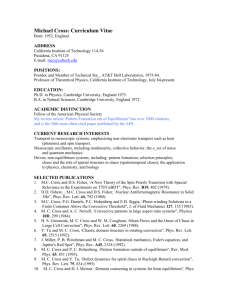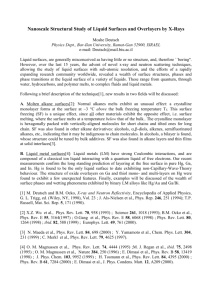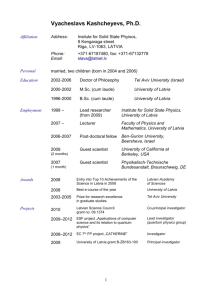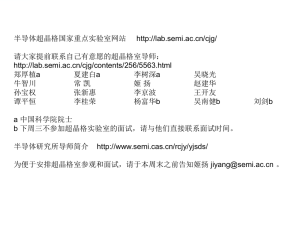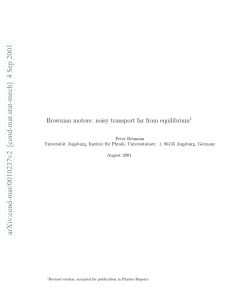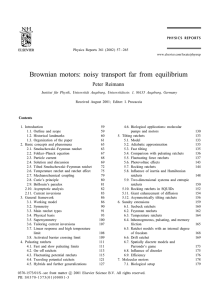References
advertisement
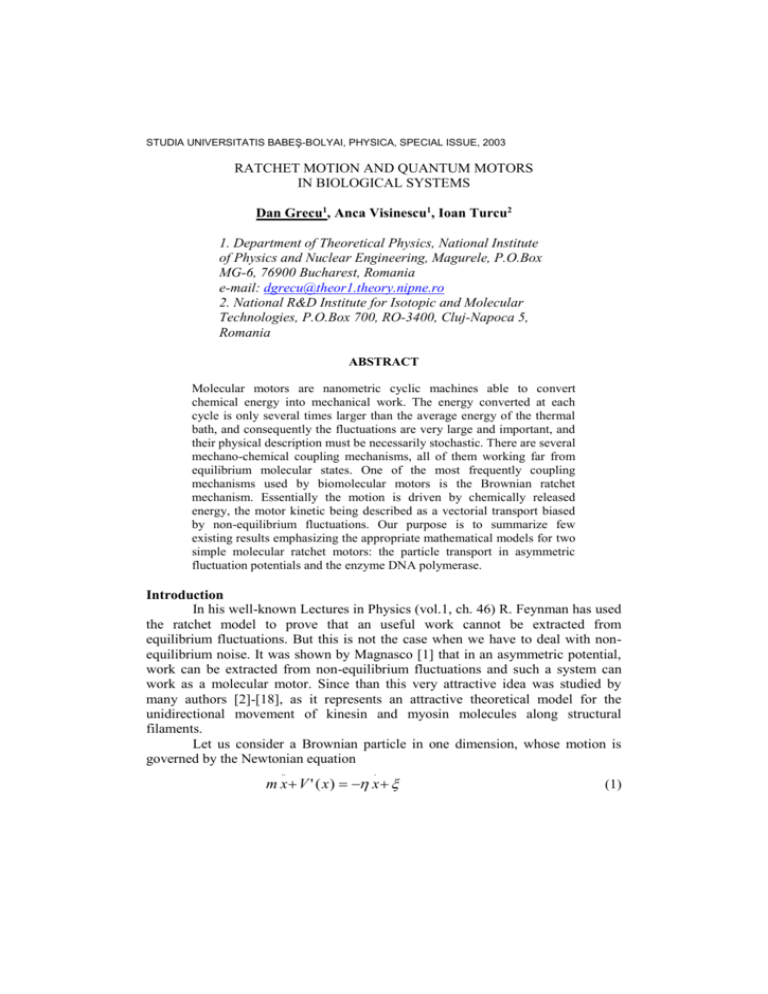
STUDIA UNIVERSITATIS BABEŞ-BOLYAI, PHYSICA, SPECIAL ISSUE, 2003 RATCHET MOTION AND QUANTUM MOTORS IN BIOLOGICAL SYSTEMS Dan Grecu1, Anca Visinescu1, Ioan Turcu2 1. Department of Theoretical Physics, National Institute of Physics and Nuclear Engineering, Magurele, P.O.Box MG-6, 76900 Bucharest, Romania e-mail: dgrecu@theor1.theory.nipne.ro 2. National R&D Institute for Isotopic and Molecular Technologies, P.O.Box 700, RO-3400, Cluj-Napoca 5, Romania ABSTRACT Molecular motors are nanometric cyclic machines able to convert chemical energy into mechanical work. The energy converted at each cycle is only several times larger than the average energy of the thermal bath, and consequently the fluctuations are very large and important, and their physical description must be necessarily stochastic. There are several mechano-chemical coupling mechanisms, all of them working far from equilibrium molecular states. One of the most frequently coupling mechanisms used by biomolecular motors is the Brownian ratchet mechanism. Essentially the motion is driven by chemically released energy, the motor kinetic being described as a vectorial transport biased by non-equilibrium fluctuations. Our purpose is to summarize few existing results emphasizing the appropriate mathematical models for two simple molecular ratchet motors: the particle transport in asymmetric fluctuation potentials and the enzyme DNA polymerase. Introduction In his well-known Lectures in Physics (vol.1, ch. 46) R. Feynman has used the ratchet model to prove that an useful work cannot be extracted from equilibrium fluctuations. But this is not the case when we have to deal with nonequilibrium noise. It was shown by Magnasco [1] that in an asymmetric potential, work can be extracted from non-equilibrium fluctuations and such a system can work as a molecular motor. Since than this very attractive idea was studied by many authors [2]-[18], as it represents an attractive theoretical model for the unidirectional movement of kinesin and myosin molecules along structural filaments. Let us consider a Brownian particle in one dimension, whose motion is governed by the Newtonian equation .. . m x V ' ( x ) x (1) DAN GRECU, ANCA VISINESCU, IOAN TURCU where x(t) is the position of the particle, m its mass, V(x) is a periodic (period L ) asymmetric potential, η friction coefficient and ξ(t) is a Gaussian white noise of zero mean <ξ(t)>=0 and satisfying the fluctuation-dissipation relation. (2) (t1 ) (t2 ) 2k BT (t1 t2 ) Here k B is Boltzmann’s constant and T the temperature of the surrounding bath at equilibrium. A typical saw-tooth form for V(x) (see fig.1) is considered as an example of the asymmetric potential. V(x) L x Fig. 1 Asymmetric saw-tooth potential In many cases the inertial effects can be neglected and the dynamics of the state variable x(t) is governed by an overdampted Langevin equation . x V ' ( x ) (t ) (3) The quantity of foremost interest is the average particle current . x lim t x ( t ) x ( 0) t (4) Taking into account the periodicity property of V(x) it can be written also as t L 1 V ' ( x) x lim dt ' dx P( x, t ' ) t t 0 0 . (5) where P(x,t) is the probability density associated to the random process described by (2) (it is periodic in space and normalized to unity in the unit cell [0,L]). It can be proved that in the long time limit the system described by (3) will evolve towards a Boltzman steady state solution and this implies that the net current vanishes. In other words we find once again that no preferential direction of the random Brownian motion exists at thermal equilibrium, even if the potential in which the particles move is asymmetric. This is no more true if an additional colored noise Z(t) is applied to the particle. We assume that the correlations in Z(t) are over long time intervals compared to the thermal fluctuations time scale. That in this case a net current to the left is obtained, can be seen from a very simple reasoning. Let us assume that the effect of Z(t) is to place the particle in two distinct configurations. In the first (denoted by (a)) the particle is just in the potential V(x) and localized near one of the minima of V(x). After a time 1 particle’s state is switched to a free one RATCHET MOTION AND QUANTUM MOTORS IN BIOLOGICAL SYSTEMS (denoted by (b)) and the particle start to diffuse nearly uniform to the left and to the right. After a time 2 particle’s state is switched back to the state (a) (the time scales of the switches are small compared to the equilibrium time in V(x) and the diffusion time L2 k BT ). Because the diffusion in state (b) starts from a region closer to the basin of attraction of the next left unit cell, it is a higher probability that the particle will be captured in the next left cell than in the right one. The result is a net flow of probability to the left and a steady current in this direction. In this scenario both the anisotropy of the potential V(x) and the non-white property of the noise play an essential role, and it will be referred as the “flashing ratchet”. Another possibility is to assume that the temperature T of the Gaussian white noise is subjected to periodic temporal modulation with period τ , i.e. (6) (t1 ) (t2 ) 2k BT (t ) (t1 t2 ) A simple example is T (t ) T (1 A( sign 2t )) (7) where sign(x) denotes the signum function and we assume A 1 . Then the temperature jumps from T (1 A ) to T (1 A ) at every half period . This 2 situation will be called “thermal ratchet”. In the first interval the thermal energy is kept at the value k B T (1 A ) much smaller than the potential barrier (we assume A 1 ) and the particle is localized in a minimum of the potential V(x). Then the thermal energy jumps to k B T (1 A ) much larger than the potential barrier and the particle starts to diffuse freely. The same argument as before leads us to the conclusion that a net current to the left will appear. The energy necessary to produce these jumps of the temperature might come from the hydrolysis of the adenosine triphosphate. The ATP hydrolysis energy is quickly converted into a very irregular vibrational motion of the fast internal degrees of freedom of the enzyme, giving rise of the local temperature. This excess heat spreads out after that and the temperature falls down and the process repeats again in a stochastic manner. If we denote by P (t ) the probability of the potential to be in the state V V (x) at time t, and by P (t ) the probability to be in the state V 0 (flashing ratchet) they were satisfying a master equation P b a P ( ) ( ) ( ) b a P t P (8) DAN GRECU, ANCA VISINESCU, IOAN TURCU Here γ defines the correlation time scale of the flashing, c 1 , and the numbers a and b are specifying the steady state probabilities of the potential, a b to be in the state V and in the state V . ab ab The joint probability density of the particle to be found in the point x with the potential in one V or V state, ( x, t ) , satisfies a coupled Fokker-Planck equation K b ( x, t ) ( )( b t ( x, t ) a )( ) K a (9) where the position evolution operator is given by K 1 (1 1) V ( k BT ) x 2 x x (10) Periodic boundary conditions on [0,L] are considered. The marginal density for the position process is ( x, t ) and is normalized to unity. It satisfies a continuity equation J 0 (11) t x and the steady-state current is given by J lim j ( x, t ) and must be independent t of x. Analytical calculations can be done only in some limiting situations, namely for a “slow flashing” limit when (small γ) J can be expanded as (12) J J (1) 2 J ( 2 ) ... or a fast flashing limit ( c 0 ) when J c J (1) c2 J ( 2) ... . (13) In both limit of very slow flashing ( 0 ) or very fast one ( c 0 ) we see that J 0 . In the first case the current tends to the averaged current produced in each potential configuration, which is zero, while in the second case the result current would correspond to an averaged potential, which also vanishes. Consequently there is a optimal flashing rate γ giving a maximum current. Indeed, the numerical calculations give a net current to the left (J<0), depicted in fig.2. This is in complete agreement with the heuristic argument given above. RATCHET MOTION AND QUANTUM MOTORS IN BIOLOGICAL SYSTEMS -J(γ) T1 T2 γ Fig. 2 The current J as a function of γ for two different temperatures T1 <T2 The next step would be to move from the classical world and to take into account quantum effects. Recently a quantum ratchet was built [19]. The device, fabricated by nanolitography techniques, consists in an aluminum-doped gallium aersenide (GaAs/AlGaAs) quantum dot with a triangular shaped cavity, and the results support the idea that quantum effects can be observed. A first theoretical treatment [20] considers a quantum Brownian particle – an electron- at low temperature, moving in a periodic ratchet potential under the influence of quantum noise. The potential is tilled to the left and right by a slowly force (periodic or random in time). The theory predicts a finite current, even at very low temperature, an effect due to quantum tunneling. Many quantum devices could be constructed using these new concepts and the modern techniques of nanolithography. References 1. 2. 3. 4. 5. 6. 7. 8. 9. 10. 11. 12. 13. M.O. Magnasco, Phys. Rev. Lett. 71, 1477 (1993) C.R. Doering, W. Horsthemke, J. Riordan, Phys. Rev. Lett. 72, 2984 (1994) C.R. Doering, Nuovo Cimento D 17, 685 (1995) M.O. Magnasco, Phys. Rev. Lett. 72, 2656 (1994) J. Prost, J.F. Chawin, L. Peliti, A. Adjari, Phys. Rev. Lett. 72, 2652 (1994) A. Adjari, D. Mukamel, L. Peliti, J. Prost, J. Physique I 4, 1551 (1994) R.D. Astumian, M. Bier, Phys. Rev. Lett. 72, 1766 (1994) M.M. Millonas, M.I. Dykman, Phys. Lett. A 185, 65 (1994) M.M. Millonas, Phys. Rev. Lett. 74, 10 (1995) R. Bartussek, P. Reimann, P. Hänggi, Phys. Rev. Lett. 76, 1166 (1996) P. Reimann, Phys. Reports, 270, 149 (1997) M. Bier, Phys. Lett. A 211, 12 (1996) F. Jülicher, A. Adjari, J. Prost, Rev. Mod. Phys. 69, 1269 (1996) DAN GRECU, ANCA VISINESCU, IOAN TURCU 14. 15. 16. 17. 18. 19. H. Kamegawa, T. Hondou, F. Takagi, Phys. Rev. Lett. 80, 5251 (1998) J.M.R. Parrondo, Phys. Rev. E 57, 7297 (1998) C.R. Doering, Physica A 254, 1 (1998) P. Reimann, P. Hänggi, Appl. Phys. A 75, 169 (2002) P. Reimann, R. Bartussek, R. Häussler, P. Hänggi, Phys. Lett. A 215, 26 (1996) H. Linke, W. Sheng, A. Löfgren, Hongqi Xu, P. Omling, P.E. Lindelot, Europhys. Lett. 44, 341 (1998) 20. P. Reimann, M. Grifoni, P. Hänggi, Phys. Rev. Lett. 79, 10 (1997)


